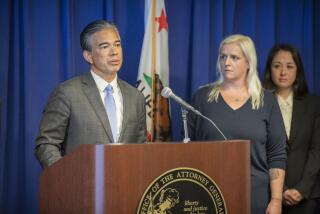Catholic Church Alters Tactics on Suicide Law
- Share via
PORTLAND, Ore. — The Roman Catholic Church led the fight against doctor-assisted suicide in 1994--and learned a tough political lesson.
Priests preached from the pulpit, Catholic leaders sent impassioned letters to church members, and Catholic groups gave hundreds of thousands of dollars to the campaign, including $276,000 from one weekend collection.
The landmark ballot question, called Measure 16, passed anyway, and the state’s largest religious denomination lost.
Three years later, the church is back on the political battlefield, this time under the flag of Measure 51, a November ballot question that would repeal the assisted-suicide law. But things have changed:
* Catholic sources continue to be the big font of campaign cash, but the church has learned that money alone won’t win the election.
* The church has gained some strong religious allies, most notably the Mormon Church, Oregon’s second-largest denomination.
* Catholic leaders have lowered their public profiles and played down the moral arguments that dominated their 1994 effort. Now, the campaign against assisted suicide focuses on medical issues and the workings of Oregon’s law.
“We have stayed in the background,” said Auxiliary Bishop Kenneth Steiner of the Archdiocese of Portland. “We didn’t want this to backfire on us as it did in 1994, when they said this is the Catholic Church, or the religious right, or religious extremists, or conservatives.”
*
The new strategy for Tuesday’s mail election takes its cues more from polls and political consultants than from the Bible. It has put doctors in the pulpit instead of priests.
“We’re focusing on the medical arguments entirely,” said Dr. Gregory Hamilton, a psychiatrist who addressed the congregation at St. Thomas More Catholic Church several Sundays ago.
“I told them there are Christian reasons for not wanting to do [assisted suicide], but that the medical one is the real issue,” he said. “Even in the religious setting, people need to know the facts, the medical facts.”
Hamilton is co-founder of Physicians for Compassionate Care, a group of anti-assisted-suicide doctors formed after Measure 16 passed.
Oregon’s assisted-suicide law lets mentally competent, terminally ill patients request a prescription for lethal drugs from their doctor. Hamilton and others argue that the drugs won’t work effectively and say doctors are known to make mistakes in predicting when someone might die.
Measure 16 supporters dispute those claims. The argument they emphasize is a moral one: Dying patients should have a right to choose suicide if the solution is best for them.
The role of churches in the Measure 51 campaign has not been in the spotlight. But Barbara Coombs Lee, a chief sponsor of Measure 16 and a leader in the anti-repeal campaign, has criticized the Catholic Church, not as a faith but as a political opponent.
*
Lee called the church “one of the most powerful political forces in the state.” In a campaign fund-raising letter last month, she said Catholics, antiabortion groups and the Oregon Citizens Alliance, which has opposed abortion and gay rights, are behind the effort to repeal assisted suicide.
Steiner, the auxiliary bishop, said attacks on the church reflect a disturbing intolerance of the state’s more than 300,000 Catholics. Church-affiliated groups run 13 hospitals and half a dozen nursing homes in the state, Steiner said.
“We’re not imposing our morality on them,” he said, “but defending our morality, a morality that is as true for Catholics as it is for anybody. This isn’t just the law of the church. We defend God’s laws, which say, ‘Thou shalt not kill.’ That has been a law throughout history for everyone.”
Still, the Catholic Church remains the dominant financial player. In 1994, almost half the$1.5 million spent in opposition to legalization of doctor-assisted suicide came from Catholic dioceses and Catholic hospitals in Oregon and elsewhere. As of Sept. 24, the committee to repeal the measure had raised $2.3 million, about half from the Catholic Church and related organizations.
The Mormon Church is more active in opposing doctor-assisted suicide than in 1994, when it did little more than urge the state’s 130,000 Mormons to vote.
On Oct. 19, each of Oregon’s more than 250 Mormon congregations was read a statement from the First Presidency and Quorum of the 12 Apostles, the church’s highest offices, in Salt Lake City.
*
It said that “one who assists in the suicide of another violates God’s commandments” and urged members to participate in the “Yes on 51” campaign by contacting campaign headquarters, writing letters to the editor and putting signs in their yards. The church also has donated $50,000 to the campaign.
Steiner said Mormon officials told him they “are standing shoulder to shoulder with the Catholic Church” and will fight assisted suicide “anyplace in the country where it raises its head.”
Because many evangelical churches are independent and not affiliated with a top-down denomination that can organize people quickly, their role has been less defined. Still, many have taken a stand.
Some services at Good Shepherd Community Church in the town of Boring, near Portland, included a videotaped interview with Dr. William Toffler, president of Physicians for Compassionate Care, a group of anti-assisted-suicide doctors. After the videotape was played, the Rev. Barry Arnold told his congregation: “It’s very clear how to vote on this issue, and it’s very clear how God would vote. But he can’t vote. He’s depending on you.”
More to Read
Sign up for Essential California
The most important California stories and recommendations in your inbox every morning.
You may occasionally receive promotional content from the Los Angeles Times.










